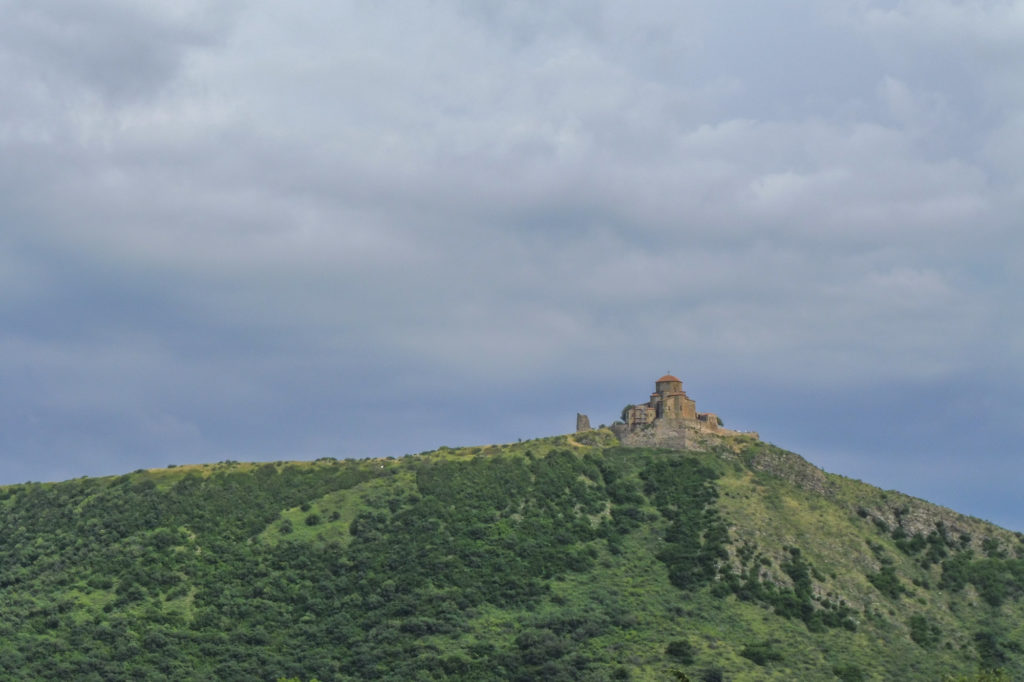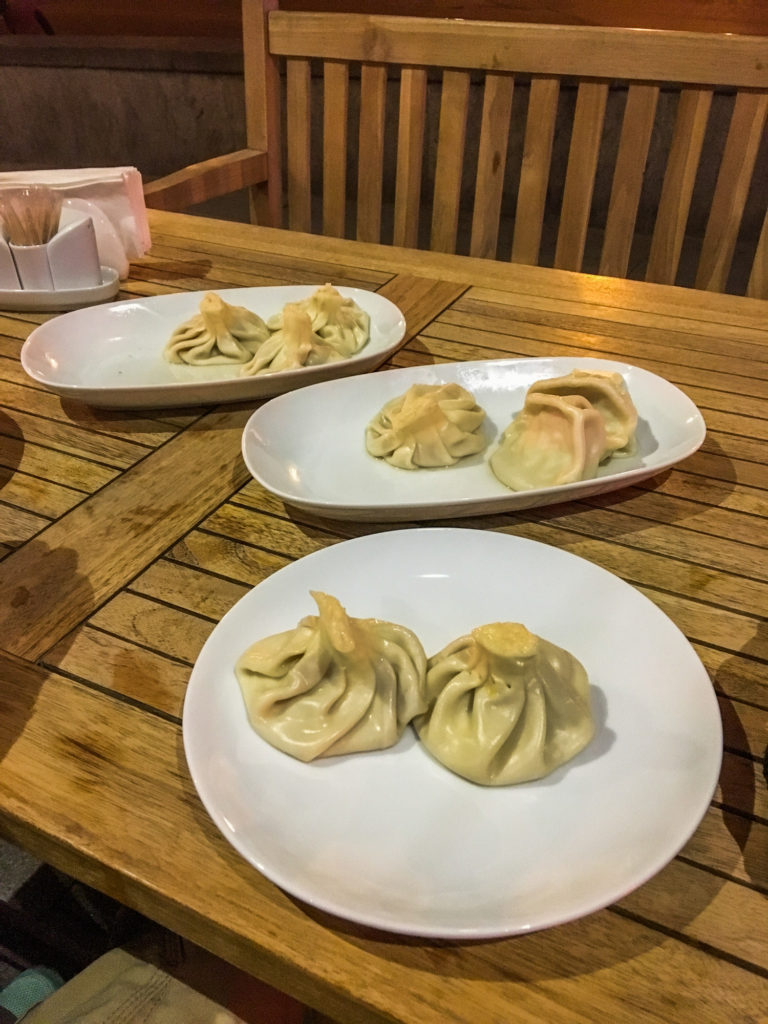Morourama Part 37: Tbilisian Culture
Hello family, friends and followers! This will be the second and last Travel Story from Georgia, before continuing on to Azerbaijan.
The day after our night of partying Georgian style, we had a late start due to Denise’s rumbling stomach. The prospect of driving wasn’t the most fun thing to think about and the hangover was still making her suffer, but all in all it could have been worse, so we set off for Tbilisi in the beginning rain.
Esben’s Honda NX250 was still making the unnerving rattling noises, but as we could not find the source, and Falkor was driving steadily, we decided to try our luck and hoped he would live up to the Honda reputation of reliability.
After a while of driving on the main highway to Tbilisi, Denise’s speedometer went dead again. We went to stop at a very touristy monastery, called Samtavro Monastery just outside Tiblisi. She was trying to re-hydrate a little bit too much, so the water wanted to come out. You would think a well visited place like that would have toilets available. Sadly, due to our lack of knowledge of Georgian words and the nuns’ lack of English, there was no toilet to be found. Esben suddenly saw Denise running out of the monastery into the nearest bush across the street. While Esben kept on taking pictures, she relieved the pressure of her bladder and was in a far better mood afterwards and we had a small picnic of raspberries and cookies to strengthen us for the rest of the way to Tbilisi.
We arrived in the city having avoided the rain all the way, except for when we set off from Kharagauli. Getting through Georgian traffic in the big city was an adventure in itself. They don’t seem to be used to motorcycles in the traffic, and we were often cut off. The predetermined lanes on the road were more a rough guideline of where to line up your car, and people would switch lanes all willy nilly. After getting used to this, we drove extra careful. Georgia was also the first country, where we experienced a perceived 50% of cars were right hand drive, even though they drive on the right side of the road. This makes it even more difficult to know if someone has seen you. It turns out that it has been much more economically appealing to import cars from England and Japan, rather than from countries with left hand drive cars, for the majority of the population. This changed a couple of years ago, though, and new rules forbid the import of such cars now.
After the adventurous ride into town, we arrived at our lovely guest house ‘Hostel 48a’, with a lush inner yard of plants and flowers. Our hostess was kind enough to let us park our two small Honda NX250s inside, despite us taking up most of the courtyard.
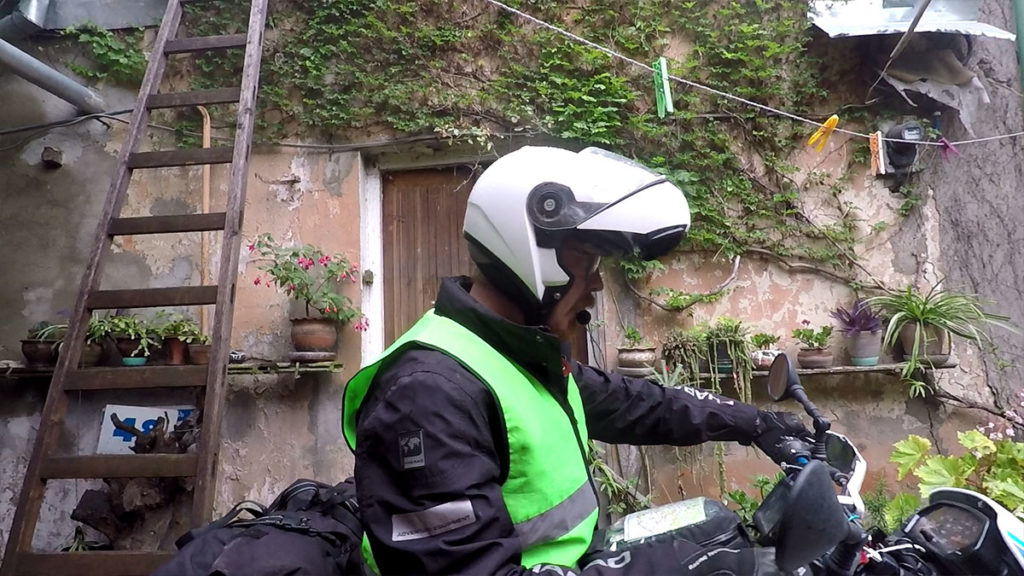
Esben, highly concentrated, parking Falkor without destroying the various pots of plants and the plants themselves.
The first evening in Tbilisi, we went around the neighbourhood of the guest house, buying ingredients for a home cooked meal, as well as other necessary items (toilet paper, for instance, just in case).
The next day, we went on the hunt for a capable motorcycle workshop. Having left the last official Honda Motorcycle workshop behind in Istanbul, Turkey, we made contact with two promising places via Facebook (oh, the wonders of the internet!) and asked them about the availability of parts for our motorcycles. Falkor’s rear tire was getting thin in the back, and the chain needed to be replaced. We needed brake pads for Falkor, as well as new oil and oil filters for both bikes, along with new fuel filters, just in case. It must be said now (we probably have mentioned this before and will probably mention it again) that finding parts for our lovely Hondas is not that easy, the further we get away from Europe. They are not that common, and use uncommon sizes for the most parts.
One of the workshops replied, that they sadly did not have any of the parts, while the other replied that they most likely could get a hold of the things we needed. With a smile we set off to find them. We had an address and a phone with a map. After a bit of adventurous city traffic, we reached the workshop even before it had opened. To kill the time until they opened, we took Phoenix’s front apart, to check the speedometer gear, which we were almost sure would be dead again.
For new readers; the speedometer gear of the Honda NX250 is prone to shed its teeth, as it is made out of nylon, which gets brittle with age. As no new parts are made for the bikes anymore, the speedometer gears that still exist are rare and old. Rare equals expensive (40€ for one) and old equals brittle. Not a good combination.
Upon inspecting the speedometer gear, we found it to be in fine condition, albeit a bit gunked up with the grease we used to keep it lubricated now full of road dust. We gave it a clean and new grease and put it back in. Now the hunt went on for the actual culprit. After a short while of investigation, we narrowed it down to one suspect: the speedometer cable. We were not absolute certain, but we were a good 90% sure.
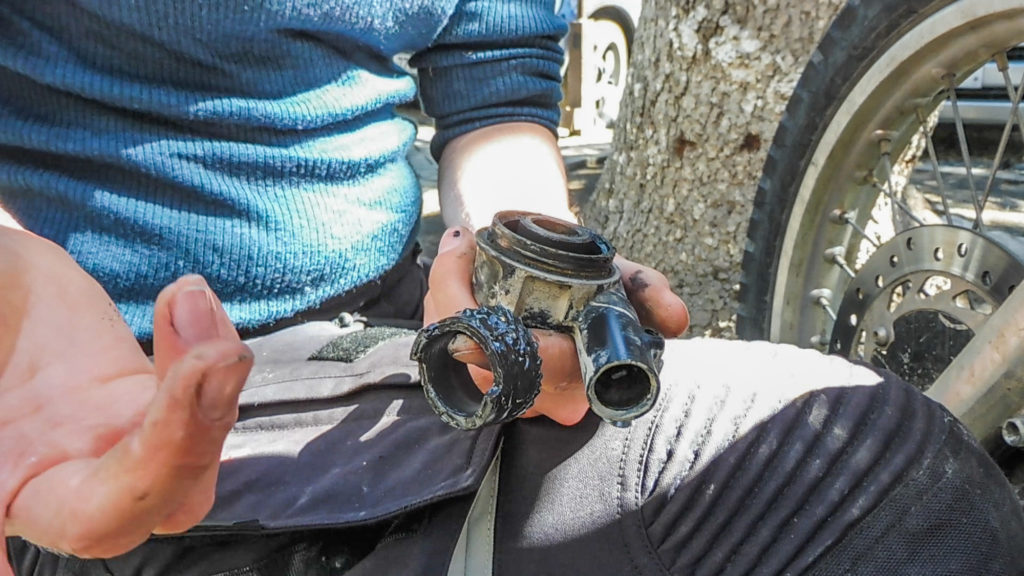
Almost black from road dust stuck in the grease. It should be a creamy color. Despite of that the speedometer gear is intact.
In the time we had used to search for the source of the problem, the workshop had opened, and we went in to say hello and get started with the parts and oil. After we introduced ourselves as the couple who wrote about the parts for the two Honda NX250, we got a confused look from the guy behind the counter. He had a quick talk with the rest of the mechanics, and it turned out that Esben had expertly navigated us to the wrong place, that did not have the parts we needed. Whoops! We just had a laugh at the situation, packed up our tools, and went on the hunt for the right workshop.
For that one, we had two potential addresses. One from Google Maps and one from Google search engine. We chose to go for the Google Maps address, as it had a Street View photo of a bunch of motorcycles in front of the address. This turned out to be the wrong one. Instead there was a newly opened hair salon at the address. Oh well, you can’t be lucky everyday. We went off for the second address and our last hope to find our needed parts. As we arrived at the address, we were greeted with more motorcycles in one place, than we had seen throughout Georgia so far. It was the right spot, Bikeland, and the owner of the workshop gave us a warm welcome. He had been expecting us.
As the shop owner had had time to call around to friends and other shops in Tbilisi, while we were making our way from one wrong address to the next, he had a good news/bad news situation for us. He had not been able to get a rear tire for us. He did have the right oil filters, though, and he was still searching for the correct chain kit with optimism. While we waited for replies from his contacts, we got to work on both bikes, changing oil and oil filters (which are standard sized and easy to get), and properly checking Phoenix’s speedometer cable. It turned out our initial suspicion was right and it had snapped. Therefore the revolutions from the gear mechanics in the front wheel were not transferred into the speedometer in the instrument cluster. A new request was sent out to the Tbilisian network of motorcycle parts for a replacement cable.
Bikeland has a large shop of motorcycle equipment and parts, so we had a look for fuel filters and brake pads, while waiting for news from the network. Sadly, we encountered a lack of parts in the shop compatible with our chosen steeds. After a bit more waiting without response regarding the other parts, we agreed to come again the day after.
We returned with the bikes to our guest house, and as the day was still young, we decided to take a stroll into the city. Our goal was a massive orthodox church, called the Tbilisi St. Trinity Cathedral, sitting on a hill in one of the older parts of the city. We got there in time for sunset, which made for a beautiful scenery.

The cathedral from the front. It is massive! In fact the largest cathedral in all of Transcaucasia. It was build from 1996 to 2004.
After the final rays of the sun had disappeared behind the mountains in the west, we made our way down from the hill into the city center, with the church in the fading light of the sky. As the day turned to night, the city came to life with its lights. We found a cozy restaurant in Erekle II street brimming with excellent eateries. The food was, as we have come to expect from Georgia, delicious. With our appetite satiated, we made our way back to the guest house for the night.

The amazingly cheesy khachapuri. Yes, those are slices of cheese on melted cheese. Think Chicago style pizza filled with nothing but cheese. So much cheese!
The following day, we went back to Bikeland, but they had sadly not been able to track down the rest of the needed parts. We thanked them for their efforts and great help regardless.
To finish off our stay in Tbilisi, and to get deeper into the city’s authentic, pulsating, cultural veins, we found Tbilisi Free Walking Tours. Our guide was Levan, the founder of the organization and a very knowledgeable man on the city’s history and culture. It was a most informative and wholly awesome tour, off the beaten tracks. We hope our pictures do the tour justice.

Those are not weird candles, they are a fruity, Georgian specialty called churchkhela. It is different kinds of nuts on a string dipped in fruit syrup, much like dipping candles. You could call it the Snickers of the middle ages. A tasty snack!
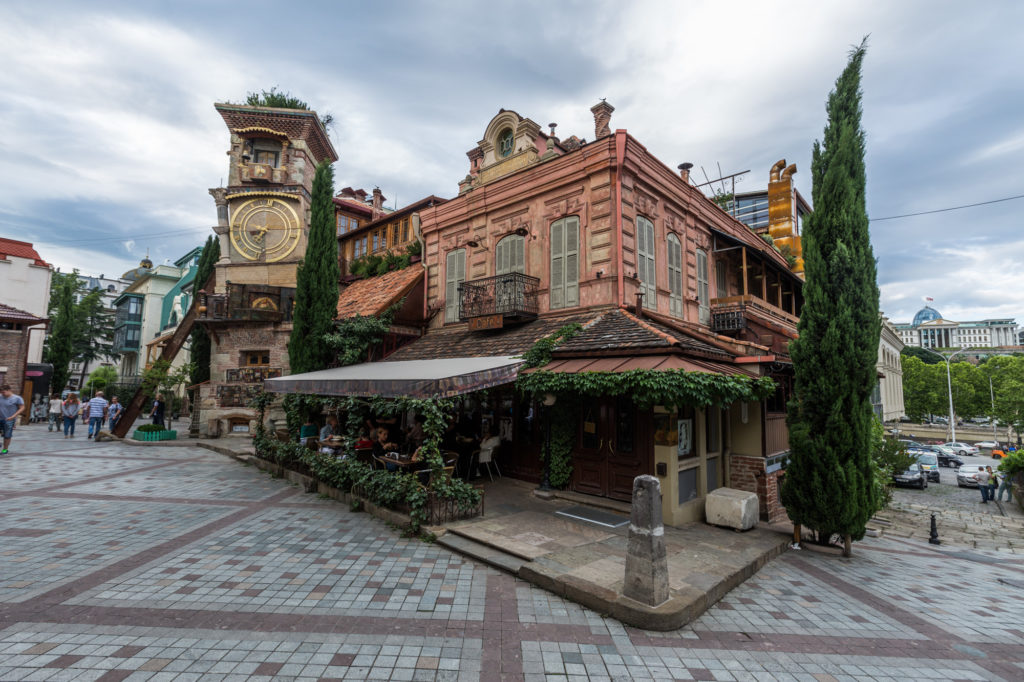
A new addition to the old part of town – a wonky clock tower full of funny details: The Leaning Tower Of Tbilisi. It apparently has the smallest clock on a tower. Can you find it? Zoom in, get a little closer…

Small stream surrounded by bath houses. The blue, mosaic one is the unique Orbeliani Bathhouse. Tbilisi is famous for its natural hot springs.
In the evening we went up on a mountain side with a cable car to the Narikala Fortress and the impressive statue Mother of Georgia, with an astonishing view of the city from above for the sunset.
After the sun had set, we went back down again to enjoy yet another great meal. Tbilisi had turned out to be a gem for us. We had had almost no expectations of the city, so it ended up being a great few days of discovery for us.
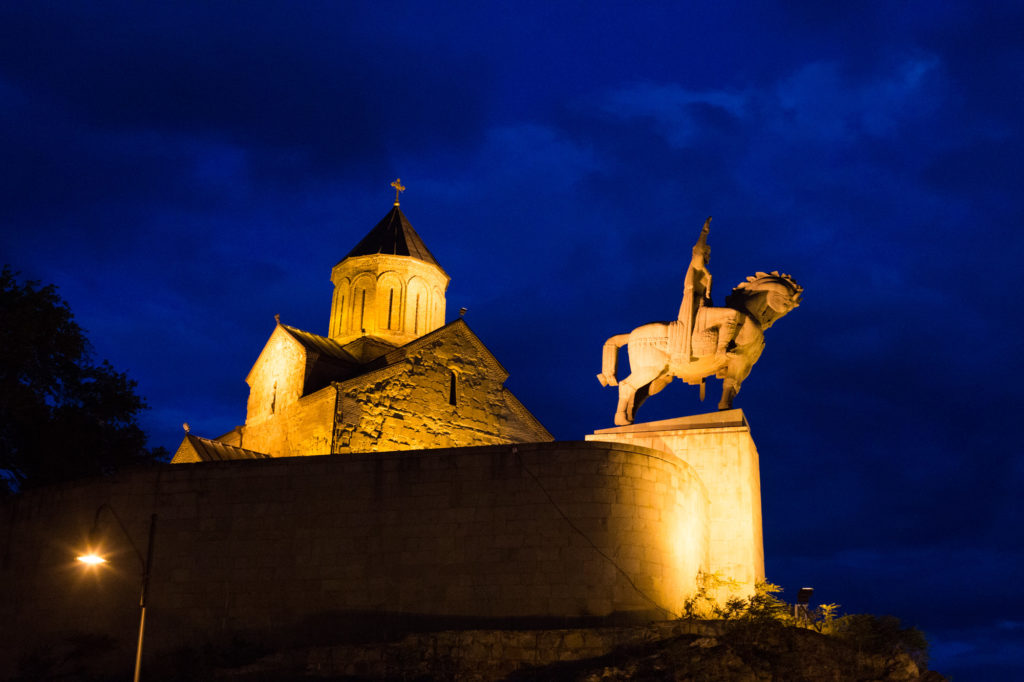
The monument of the founder of Tbilisi: King Vakhtang Gorgasal I. According to legend, he went hunting in 458 A.D. when his falcon caught a pheasant, but both birds fell into one of the natural, sulfuric hot springs and died. The king, impressed with the heat of the hot springs, decided to build a city there, Tbilisi, which comes from the old Georgian word tpili, which means “warm”.
We hope that you enjoyed the tale of our adventures in the Georgian capital, and to have awoken your interest in Tbilisi. Definitely worth a trip! We will come back there one day.
Until next time, explore a new place without doing research until you get there. Let yourself be surprised. It can be very rewarding.







